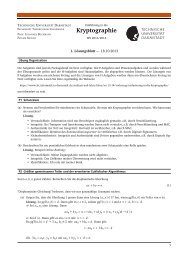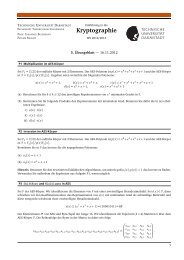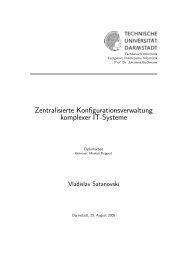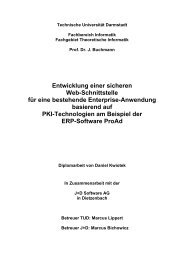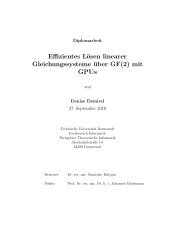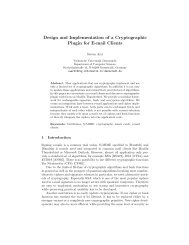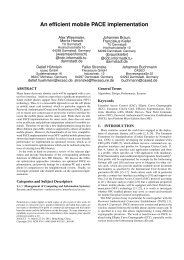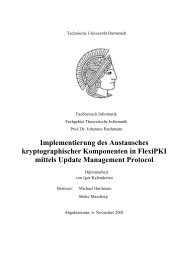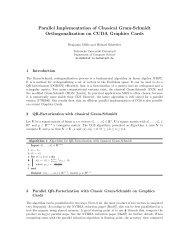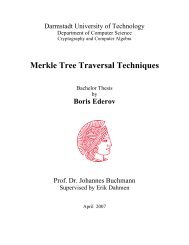Lattice Basis Reduction in Infinity Norm - Technische Universität ...
Lattice Basis Reduction in Infinity Norm - Technische Universität ...
Lattice Basis Reduction in Infinity Norm - Technische Universität ...
Create successful ePaper yourself
Turn your PDF publications into a flip-book with our unique Google optimized e-Paper software.
4.4 Comput<strong>in</strong>g the Distance Functions <strong>in</strong> Inf<strong>in</strong>ity <strong>Norm</strong><br />
The problem of comput<strong>in</strong>g the distance functions for the l∞-norm is actually<br />
an optimization problem:<br />
Given is a basis b1, b2, ...., bm and x ∈ R n .<br />
Compute Fi(x) = m<strong>in</strong>zi∈R � x + � i−1<br />
j=1 zjbj �∞ such that<br />
s.t.<br />
zi ≥ 0 (1)<br />
zi := � x +<br />
−zi ≤ xk +<br />
�i−1<br />
j=1<br />
zjbj �∞<br />
(2)<br />
�i−1<br />
zjbj,k ≤ zi, for all k = 1, ...., m (3)<br />
j=1<br />
We get the follow<strong>in</strong>g optimization problem:<br />
M<strong>in</strong>imize Q(x) = zi<br />
zi ≥ 0 (4)<br />
zi ≤ � x �∞ (5)<br />
�i−1<br />
zjbj,k − zi ≤ −xk (6)<br />
j=1<br />
�i−1<br />
− zjbj,k − zi ≤ xk, for all k = 1, ...., m (7)<br />
j=1<br />
Such an optimization problem is solved <strong>in</strong> polynomial time for all rational<br />
<strong>in</strong>put values with the help of the Ellipsoid Method or the Karmarkars<br />
Algorithm. In practice the Simplex Algorithm is even more efficient.<br />
The best and quickest way to solve such a problem would be to use the<br />
ILOG CPLEX Software, which is a large-scale programm<strong>in</strong>g software that<br />
is capable of solv<strong>in</strong>g huge, real-world optimization problem. The problem is<br />
simply written <strong>in</strong> the respective CPLEX language and the software f<strong>in</strong>ds a<br />
solution if there is such.<br />
Another option is to model the problem <strong>in</strong> a language that translates the<br />
mathematical model <strong>in</strong>to a l<strong>in</strong>ear or mixed-<strong>in</strong>teger mathematical program,<br />
like for example Zimpl [5], and solve the result<strong>in</strong>g problem us<strong>in</strong>g JAVA. This<br />
approach is not as quick and affective as the first one but is the only way to<br />
solve such an optimization problem without expensive software.<br />
18





